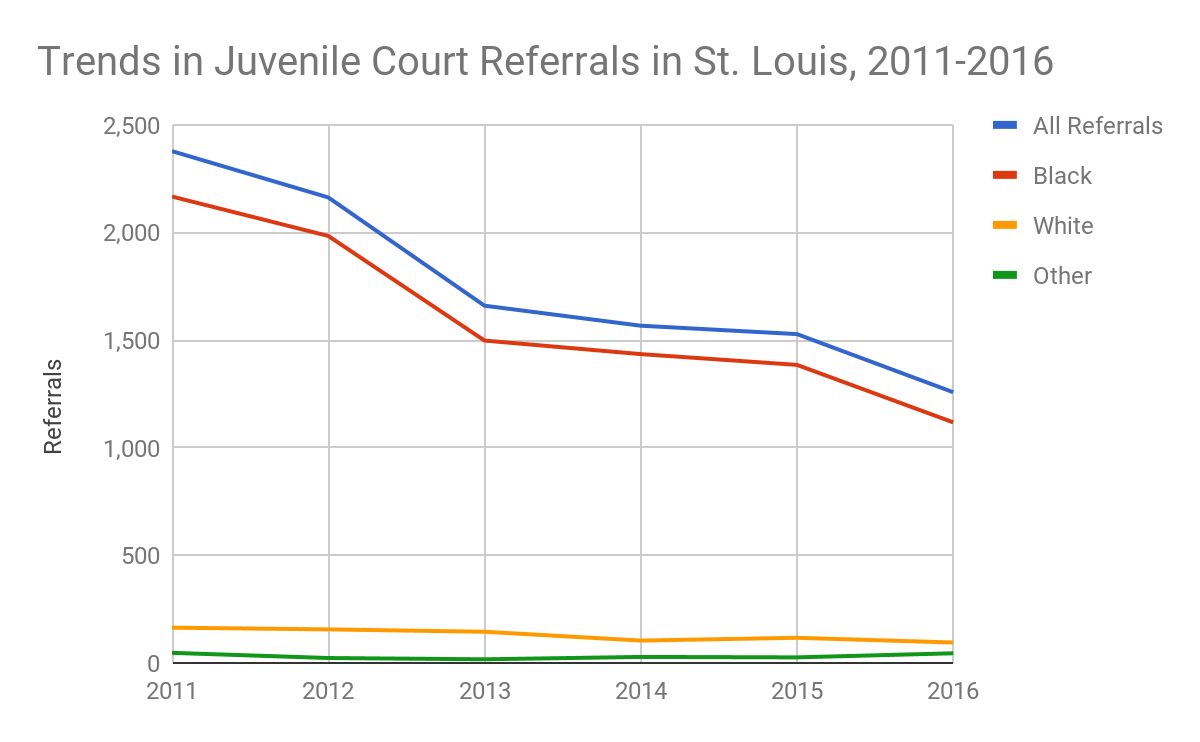Juvenile Referrals to Court
The rate at which children are referred to the 22nd Circuit Family Court, which serves the City of St. Louis
Black children are nearly five times as likely as white children to be referred to juvenile court.
A score of 100 represents racial equity, meaning there are no racial disparities in outcomes between black and white populations. The lower the Equity Score, the greater the disparity.
For Juvenile Referrals to Court, a score of 100 — a score reflecting racial equity — would mean black and white children are equally likely to be referred to St. Louis City Family Court. It is important to note that for this indicator, equity is not our only goal: we also want to improve outcomes for all.
More Information
What does this indicator measure?
Juvenile Referrals to Court measures the rate at which children are referred to the 22nd Circuit Family Court, which serves the City of St. Louis. Children are referred to court mostly for misdemeanors (39% of all referrals), felonies (25%), and status offenses (26%). Status offenses are non-criminal but a violation of law due to the youth’s status as a minor, and include truancy, alcohol use, and violating curfew. In 2016, there were 1,258 children referred to court, which equates to a rate of 52.5 referrals per 1,000 children. While this represents a 48% decrease since 2011, black children have consistently comprised around 90% of all referrals.
Juvenile Referrals to Court analysis
Juvenile court referrals per 1,000 children age 10-17
| All | Black | White | Disparity Ratio | Equity Indicator | |
|---|---|---|---|---|---|
| Juvenile Court referrals | 1,258 | 1,118 | 95 | - | - |
| Children age 10-17 | 23,953 | 16,251 | 6,899 | - | - |
| Juvenile Court referrals per 1,000 children | 52.5 | 68.8 | 13.8 | 4.996 to 1 | 21 |
Data Source: 22nd Circuit Family Court, 2016; Missouri Census Data Center, 2016.
What does this analysis mean?
Black children are more than six times as likely as white children to be referred to juvenile court. In 2016, there were 33 referrals for every 1,000 black children. For every 1,000 white children, there were 5 referrals. If court referral rates were equitable, there would have been 898 fewer black children referred to Juvenile Court.
Data Note: Some children may have more than one referral. Hispanic origin was not provided by the Circuit Court, so these racial groups include both Hispanic and non-Hispanic children. At the date of publication, children over age seventeen in Missouri are treated as adults by the court system. There were no children under age ten referred to the juvenile court in 2016.

Why do Juvenile Referrals matter?
The majority of juvenile court referrals are an outcome of police discretion. Many juvenile offenses are handled informally outside of the court. While the goals of our juvenile court are rehabilitation and restorative justice, when a juvenile is referred to court, they are at risk of a formal prosecution and acquiring a legal record. Juvenile records are not automatically sealed and are increasingly used to deny former juvenile delinquents job opportunities and housing. Additionally, children referred to juvenile court represent some of our most at-risk children, who suffer from behavioral issues, poor judgment, and are vulnerable to negative peer influences.
Which Calls to Action from the Ferguson Commission are linked with this indicator?
The Ferguson Commission calls to action related to juvenile justice include:
- Reform Juvenile Disciplinary Procedures and Practices
- Adopt Alternative Strategies for Juvenile Interventions
- Foster Positive, Proactive Police Interactions with Youth
- Assign Public Defenders for Criminally-Charged Minors
- Reform School Discipline Policies
- Close Records of Non-Violent Offenses by Minors
Questions for further investigation
- Why is there a racial disparity in Juvenile Referrals?
- What can St. Louis do to reduce racial disparities in Juvenile Referrals?
- What initiatives are currently underway to reduce racial disparities in Juvenile Referrals?
How can I learn more about this issue?
The St. Louis City Family Court issues an Annual Report Card. The court has worked to reduce juvenile referrals through the Juvenile Detention Alternatives Initiative. The Juvenile Detention Alternatives Initiative was launched in 1992 by the Annie E. Casey Foundation to demonstrate that jurisdictions can establish more effective and efficient systems to accomplish the purposes of juvenile detention. The Foundation expanded to parts of Missouri, including St. Louis, in 2006.
The National Center for Juvenile Justice issues an annual briefing book, a comprehensive online resource describing various topics related to delinquency and the juvenile justice system.